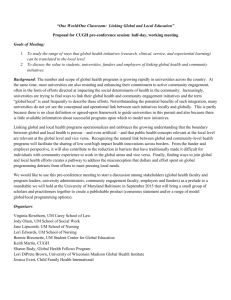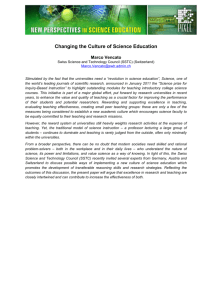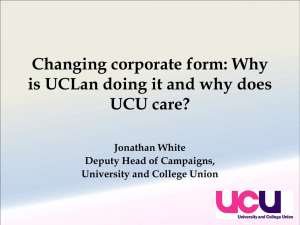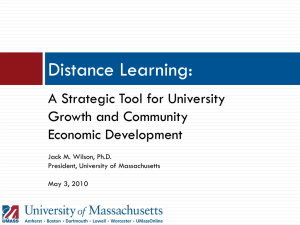Innovation in an Era of Disruptive Change
advertisement
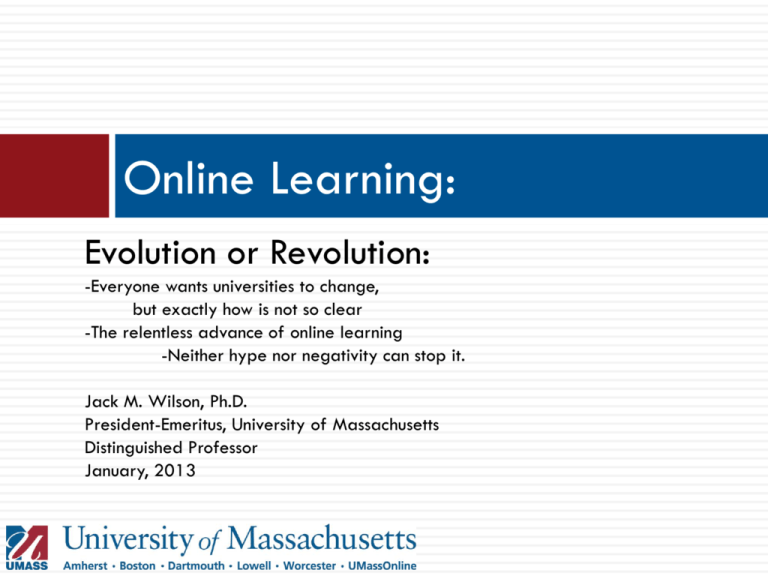
Online Learning: Evolution or Revolution: -Everyone wants universities to change, but exactly how is not so clear -The relentless advance of online learning -Neither hype nor negativity can stop it. Jack M. Wilson, Ph.D. President-Emeritus, University of Massachusetts Distinguished Professor January, 2013 The Paradox At the same time that Universities are facing extraordinary financial pressures due to a collapse of state revenue and endowments Everyone is looking to Universities to lead us out of the economic decline Creating futures for students and communities And solving social challenges like improving college readiness Reducing disparities (racial, economic, gender,etc) Increasing graduation rates Attracting students into STEM fields Better matching workforce needs President Obama’s Goal To be first the world by 2020 in the proportion of college graduates. -Address to Congress on Feb. 24, 2009. The US was tied for 6th place at 30% according to 2006 data. The Catalyst for the Future What do Boston, Bombay, Beijing, Bangalore have in common with San Francisco, Austin, Raleigh, Cambridge, and other world economic leaders? They are vibrant economic regions nucleated by world class universities. The Secret Sauce? Universities pouring out highly educated graduates with skills and intellectual property. World class research that is curing illnesses and creating new jobs, companies, and even entirely new industries. And doing this at very large scale. The Path I love to say: “The path to economic and social development in Massachusetts goes through the University.” It is fair to say that the path to economic and social development in the world goes through our world class universities, and through the continuum of world class education from K-Retirement. Change But it is not your father’s (or mother’s) university any more. The Ivory Tower has cross-pollinated with the Silicon Village through the information superhighway to create: A more engaged university – in many ways fulfilling the 21’st century vision of the original land grant mission. Not everyone believes! Higher Education Costs too much? This widely held political position is most notable for the lack of understanding of why this might be –if indeed it really is! Nonetheless- we should buckle our seatbelts for a ride to drive down the cost of higher education -and many of the “well meaning” efforts will be far more damaging than helpful. Some will be downright foolish like government attempts in Florida and Texas to mandate $10,000 bachelor’s degrees –based upon political rather than academic considerations. But far too many are in denial While change has actually been rather large scale, the conventional wisdom is that there has been little change. It is also probably accurate to say that even the large scale changes have not penetrated the culture of higher education nearly as much as necessary. There is no shortage of contrarian voices that decry even those changes that HAVE occurred. The disparity is creating a vacuum into which politics is inevitably drawn. Goal Provide some philosophical framework and tools to analyze, select, and deploy educational innovations that promise Enhanced Quality Enhanced Access Reduced cost Provide some historical perspective to help avoid being swept up by the hype over-run by the changing landscape Create enhanced understanding of potentially useful educational innovations. The dangers of hype Students get hurt by well meant, but poorly designed experiments. Money gets wasted at a time when every dollar is precious in higher education Good ideas get discredited by over-reaching and then failing. To anyone in the audience that I offend, I offer this prior apology but….. I hope that it encourages you to adopt a position of scientific skepticism and innovative optimism. How can we do this –and preserve and enhance Quality ? The only way we can possibly approach these goals is through a much more intense focus on online learning and technology enhanced learning. Otherwise we do not have the traditional capacity to meet the increased needs for both quality AND quantity. Need to deliver educational experiences to K-12 that are not presently uniformly available. Improve success, retention, persistence, and graduation rates through higher quality learning experiences. Reach students unable to participate in traditional learning settings for a variety of reasons. Are we ready? The 3 C’s - the forces on education -* Computers Communication Cognition Many of the innovations that catch the eye of the public do a good job on the first two and a lousy job on the third. We know much more about how students learn, and learning environments need to change to create the engagement that leads to student learning. That is indeed happening at many places The NCAT, NRC Report, White House Conferences * "Using the Computer in Teaching Physics," J.M. Wilson, Physics Today 42(1) (January 1989).). Cognition My involvement with the recent NRC report reminded (and saddened) me to note that educational innovation often reinvents the wheel rather than advancing our understanding –based upon the research on the way students learn. There are notable exceptions like: The National Center for Academic Transformation The Rensselaer Studio Courses Carnegie Mellon Open Learning Initiative (OLI). Many others but not enough. TheNCAT –A brief mention Whenever anyone suggests that you cannot simultaneously enhance quality, access, and cost in traditional universities, I always ask them to look at the website of the National Center for Academic Transformation. Conventional wisdom is that universities do not change, but many do –and many are documented here. It is particularly notable because many of these reforms were driven by research in the cognitive sciences and make student engagement paramount. Student Engagement George Kuh: The engagement premise is straightforward and easily understood: the more students study a subject, the more they know about it, and the more students practice and get feedback from faculty and staff members (ed.: and other students) on their writing and collaborative problem solving, the deeper they come to understand what they are learning and the more adept they become at managing complexity, tolerating ambiguity, and working with people from different backgrounds or with different views. George D. Kuh, “The National Survey of Student Engagement: Conceptual and Empirical Foundations,” New Directions for Institutional Research, vol. 2009, no. 141 (March 9, 2009), pp. 5–20 Are MOOCs going to change the world Too late. The world already changed without MOOCs even if Stanford, Harvard, MIT and others had not noticed! “the vast majority of people who sign up for MOOC’s don’t complete their courses, yet MOOC creators are hailed as visionaries rather than being denounced for their 10percent completion rates” –Kevin Carey –Chronicle Blog MOOCs are interesting and valuable experiments, but they are not on the critical path of online education –at least in their current form. Massive Open Online Courses MOOCs Kahn Academy -2006 Salman Kahn –non-profit -2006 Udacity -2012 Sebastian Thrun, Stanford - for-profit Coursera -2012 For-Profit – Andrew Ng, Daphne Koller, Stanford edX (MITx -2011 and edX in 2012) Harvard, MIT, Berkeley –non-profit Udemy -2010 Eren Bali and Gagan Biyani –for profit A Brief History of “Distance Learning” Correspondence Courses TV Courses – Cable, Satellite, Videotape Interactive Video Courses (2-way satellite, videoconferencing, and now Skype) ALN – “traditional” online education MIT OpenCourseWare Carnegie Mellon Open Learning Initiative MOOCs Unfortunately many of the MOOCs look eerily like the “moving hand writes and then moves on” of the video days! The transmission (lecture) model The mainframe approach Face to Face: The Lecture Distance: TV (Cable, Video, Satellite, or MOOC) Pushes the back wall out a few thousand miles Which can become the usual on-line course organization “The 24-Hour Professor;” Chronicle of Higher Ed; May 31, 2002 Engagement Faculty with student (half done in lecture) Student with material ( reading, homework, papers, adaptive tutorials, most MOOCs, etc) Student with Student (peer learning, small groups, team based projects, studio classrooms, etc) Distributed Collaborative On-line Model Collaborative Learning, Peer Learning….. High (Hype) hopes for eLearning (circa 2000) www.UMas sOnline.net Columbia formed Fathom & teamed with XanEdu. U. of Penn Wharton School teamed with Caliber, a spin-off from Sylvan Learning. Cornell spun off eCornell with $12 million internal investment UNext created Cardean University with Columbia, London School of Economics, Carnegie Mellon, Stanford, and Chicago. Reportedly Cardean had pledged to pay Columbia, and perhaps the others, $20 million dollars if they failed within five years. Temple formed “Virtual Temple” Pensare teamed up with Duke. Click2Learn teamed with NYU Online. North Carolina, Harvard, and USC went to University Access for help in getting online. Harcourt Higher Education was launched as a college in 2000 and confidently predicted “50,000 to 100,000 enrollments within five years.” Vintage Slide: AAC&U November 2003 The horrible mismatch www.UMas sOnline.net People change very slowly Both a comfort and irritant! Technology changes very rapidly Vintage Slide: AAC&U November 2003 And Now? (Slide made Nov. 2003!) www.UMas sOnline.net Pensare is gone. Fathom is gone -needed ~$30 million from Columbia Faculty became restive, closed in early 2003 Cardean laid off half work force –”restructures”. Temple University closes virtual Temple. NYU folded NYUOnline back into the campus. Harcourt gone after enrolling 32 students in 2001. eCornell open BUT with reduced expectations. Britain’s Open U. closes US branch -$20 M later. Caliber goes bankrupt- acquired by iLearning(Sylvan). University Access -> Quisic withdraws from H.Ed. Vintage Slide: AAC&U November 2003 Lessons Learned www.UMas sOnline.net For-profit model - not proven viable for universities (NYUOnline, UMUC, etc.). Joint ventures between universities and for-profits are hard to make viable (Pensare, Caliber, NYUOnline, U21 Global, etc) It is difficult to borrow brand equity from one institution to another: (Cardean, Pensare) Brand equity does not transfer easily from a different business to eLearning (Harcourt) To succeed in business one must have product to sell (Fathom, etc.) Content is a commodity, over investment in content is often fatal. Brand and prestige are not the same. Nov. 2003 Press: Has Online Learning failed? www.UMas sOnline.net Hardly! The Red Sox, the Cubs, and 29 other teams didn’t win the world series again this year either. (ed. remember this was 2003!) Just like baseball, distance learning has it’s winners and losers! Vintage Slide: AAC&U November 2003 Content and the Value Chain www.UMas sOnline.net Given what MIT has done (OCW), how can UMassOnline compete? – Boston Globe reporter What MIT provides •Course materials No access •Reputation •Courses •Faculty •Credentials •Students •Alums •Library •Facilities Vintage Slide: AAC&U November 2003 Content? www.UMas sOnline.net The smallest part of the value chain. Introduction to eBusiness 75-125 students (business execs) $ 3000 per student (indicator of value?) A book might be $50 (content) Web site is open and free Revenue: $225,000 - $375,000 One faculty, one full time TA Content is king? Vintage Slide: AAC&U November 2003 The Value Chain Brand ~ Reputation (not just prestige) Delivery Content Peers Brand Instructor www.UMassOnline.net Vintage Slide: AAC&U November 2003 The Reality of Online Education transcends If one reads the traditional press coverage of online education it is dominated by either Skepticism Can students learn? Cheating etc Hype MOOCs will change the world and make higher education obsolete The hyper prestigious universities drive the change Not! So what is the reality and the future? Relentless Growth Sloan Alt C- Growth in Online 8,000,000 7,000,000 6,000,000 5,000,000 4,000,000 3,000,000 2,000,000 1,000,000 0 Fall2002 Fall2003 Fall2004 Fall2005 Fall2006 Fall2007 Fall2008 Fall2009 Fall2010 Fall2011 UMassOnline Growth Trajectory 45,000 40,000 35,000 30,000 25,000 20,000 Total Online & Blended Course Enrollments FY09: 40,048 enrollments (18% increase) 18% 26% 26% 21% 15,000 20% 32% 10,000 39% 5,000 60% 0 FY01 FY02 3 programs 27 programs $50,000,000 $45,000,000 $40,000,000 $35,000,000 $30,000,000 $25,000,000 $20,000,000 $15,000,000 $10,000,000 $5,000,000 $- FY03 34 programs FY04 FY05 FY06 FY07 FY08 FY09 37 programs 50 programs 57 programs 66 programs 81 programs 86 programs Total Online & Blended Gross Revenue 27% FY09: $47m revenues (27% increase) 32% 32% 29% 30% 39% 58% 88% FY01 FY02 FY03 3 programs 27 programs 34 programs FY04 37 programs FY05 FY06 FY07 FY08 50 programs 57 programs 66 programs 81 programs FY09 86 programs UMassOnline Continued Growth FY 2010 UMassOnline Enrollment 14.4% Increase to 45,815 Revenue 20.1% to $56.2 Million FY2011: UMassOnline Enrollment 12% Increase to 51,097 Revenue 16% Increase to $65.2 million FY2012: UMassOnline – growth slows Enrollment: 6.58% increase to 54,461. Revenue: 10.55% increase to $72.1 million. A Relentless Force that Will Not Be Denied Hype Online Education Luddites Creating the Future Creating strong Universities to lead us out of the great recession. Leading the world in the proportion of college graduates. Distance learning is nothing less than a juggernaut. Most Universities are struggling with their financial model Many (but not all!) traditional universities are struggling to understand the strategy. For-Profit Universities are stepping in to fill the vacuum, but are increasingly under attack for their poor performance on retention, persistence, and graduation rates and for their poor use of federal financial resources. A relentless force, but not yet what it needs to be On-line Education- once peripheral -is now strategically important. Too many leaders of traditional universities know this should be strategic, but do not know enough to actually make it strategic. Distance learning success requires: Vision, support and leadership from the top of the organization, A learner-centered environment Well-defined roles where academics, technologists, and support staff are encouraged to collaborate and do the work that they each do best. We all have work to do! Online Education –a Relentless Force Online Education: A Strategic Tool 40 While most faculty use online technology to support their teaching, too few institutions systemically and institutionally support a portfolio of programs that can be completed at online and at a distance However, for many institutions, distance and online learning is becoming an indispensible part of their strategic plans A tool that can reach diverse communities of learners in an efficient, sustainable way Providing additional financial resources to institutions. APLU Initiative in Online Learning Grant from Sloan Foundation to create a cadre Presidents and Chancellors knowledgeable about the strategic value of online learning Established APLU-Sloan National Commission on Online Learning (Jack Wilson, President, University of Massachusetts, Chair; seven Presidents; and other senior administrators) Commission Strategies: Understand the knowledge base and experience of Presidents/Chancellors re: online learning Target the key priorities and concerns of senior leadership Determine the potential of online learning to serve as a strategic tool to address those issues Develop strategies/resources that could assist Presidents and Chancellors in overcoming barriers limiting the strategic utilization of online learning 41 42 Online Learning as a Strategic Asset APLU-Sloan Benchmarking Study: Online Learning as a Strategic Asset First survey of Presidents and Chancellors regarding their attitudes and experiences regarding online learning. A significant study: Surveyed more than 850 people, including more than 300 Presidents/Chancellors. Institutions in this study represent more than 1 million students and more than 100k online enrollments. The Overarching Question: Are Universities equipped to respond to this challenge? APLU-Sloan National Commission on Online Learning 43 Surveys: APLU Presidents and Chancellors Tribal Colleges and Universities Presidents NAFEO Presidents and Chancellors 27 dialogue events: 850 participants; 300+ CEOs 43 Key Survey Findings: Is there a disconnect? Students Taking at Least One Online Course 7,000,000 6,000,000 5,000,000 4,000,000 3,000,000 2,000,000 1,000,000 0 Strategic Importance of Online Learning Critical to long-term strategy of institution Represented in institution's strategic plan Not critical to long term strategy APLU- 68% AIHEC – 62% NAFEO – 84% APLU- 41% AIHEC – 27% NAFEO – 52% APLU- 4% AIHEC – 15% NAFEO – 7% APLU-Sloan National Commission on Online Learning There IS a disconnect! 90% 80% 70% 60% Critical to Long Term Strategy 50% 40% In Institution's Strategic Plan 30% 20% 10% 0% APLU AIHEC NAFEO Online Learning as a Strategic Asset 46 46 Survey revealed that President’s know that distance learning needs to part of the strategic plan, However, many of them were not well equipped by past experience to understand how these programs, once considered peripheral, could become an integral tool of their institutions strategic plans. ONLINE EDUCATION IS CRITICAL TO THE LONG-TERM STRATEGY OF MY INSTITUTION -- FALL 2002 TO FALL 2011 -Babson Survey 70.00% 60.00% 50.00% 40.00% Agree Neutral Disagree 30.00% 20.00% 10.00% 0.00% Fall-2002 Fall-2003 Fall-2004 Fall-2005 Fall-2006 Fall-2007 Fall-2009 Fall-2010 Fall-2011 Online Learning as a Strategic Asset 48 Another striking finding from the surveys of campus leaders was the presence of a “disconnect” or gap between a recognition by campus leaders of the strategic value of online learning and the strategic utilization of online. This gap exists even at a time when online enrollments have grown an average of almost 20% per year over the past six years. Benchmarking Study Results The Opportunities Stereotypes are not correct Every sub-group teaches (full, part time, tenured, non-tenured, early and late career) Faculty are motivated by student needs Faculty recommend online Faculty with online experience are more positive 49 Who Teaches and Develops Online? Taught Online 34.4% Taught and Developed Online Developed Online All Faculty What’s in the ‘Distance’ for Online Education The Rise of the For-Profit University 52 During the 10 years spanning from 1996-1997 to 2006-2007 the total number of accredited degree granting institutions grew approximately 7.5%, The number of public institutions decreased slightly, while private institutions increased by almost 14%. Within the private sector, the number of accredited non-profit institutions decreased by more than 3%, while accredited private for-profit institutions grew by over 60%. Table 1: Changing Profile of US Accredited Degree Granting Institutions Year All Institutions Public Private Private NonProfit Private For Profit 1996-1997 4009 1702 2307 1693 614 2006-2007 4314 1688 2626 1640 986 % Change 7.61% -0.82% 13.83% -3.13% 60.57% [1] 2007 Digest of Educational Statistics: http://nces.ed.gov/programs/digest/d07/tables/dt07_255.asp 2/3 of Students Attend Schools < 50% Grad. Rate 50% 40.7% 40 30 27.6% 23.8% 20 Private for-profit, 4-year or above Private for-profit, 2-year 10 6.5% Private not-for-profit, 4-year or above Public, 4-year or above Public, 2-year 0 Less than 20% 20%-49% 50%-79% 80%+ 710 1,680 1,216 292 12% 33% 63% 85% Institutions Weighted grad. rate Source: IPEDS 2009 from Parthenon Cost of College Readiness Remediation Remediation Costs for 2- and 4-year Public Colleges $2.6 billion is spent each year on remediation in public institutions Percent of Students Receiving Remediation 34% of all U.S. students enroll in remedial classes 2.5 $2.1 B 2 Subsidies Tuition 1.5 1.54 1 $0.5 B 0.5 0.578 0.269 0.219 Public 2-year Public 4-year 0 Source: American Schools (Diploma to Nowhere, 2008) 54 Summary Universities have changed rather radically in many ways. Meteoric rise of online learning Involvement in economic development Deployment of 2 of the 3 C’s Disinvestment by government Fault lines are developing demarcating the disparity between the changes and our deployment and understanding. Hype often detracts and distracts from serious innovation The future will continue to be quite a challenge for leaders of higher education. Thank You! Jack M. Wilson President Emeritus and Distinguished Professor of Higher Education, Emerging Technologies, and Innovation. www.jackmwilson.com



